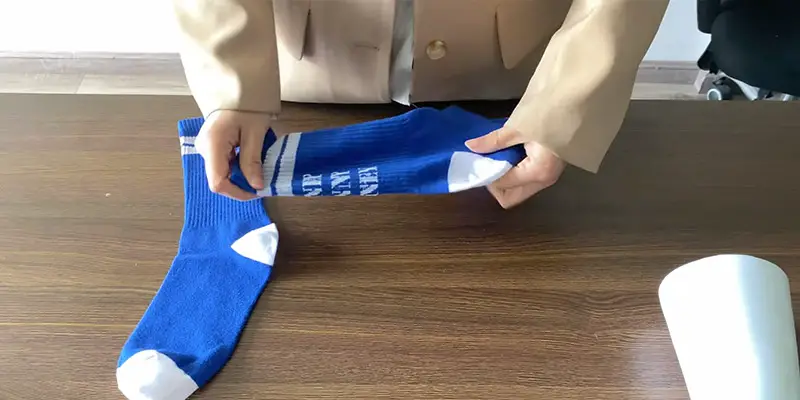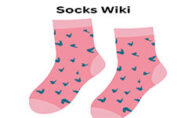Hi, I'm Christopher Bevans, the creator of SocksWiki.com. With a background in fashion design and a passion for innovation, I’m here to share my knowledge on socks from troubleshooting tips to detailed buying guides. I believe the right pair of socks can make all the difference, and through this site, I aim to help you find the perfect fit for every occasion.
Hi, I'm Christopher Bevans, the creator of SocksWiki.com. With a background in fashion design and a passion for innovation, I’m here to share my knowledge on socks from troubleshooting tips to detailed buying guides. I believe the right pair of socks can make all the difference, and through this site, I aim to help you find the perfect fit for every occasion.
Socks may seem like a small part of our daily wardrobe, but they’re packed with fun, quirky, and even surprising facts that both adults and kids will love.
From silly patterns and playful designs to unique traditions and fascinating history, socks have a story that goes far beyond keeping our feet warm.
In this guide, we’ll share 19 funny and interesting things about socks that will make you smile, spark curiosity, and maybe even inspire your next favorite pair.
Whether you’re a parent looking for fun sock trivia to share with kids or just someone who enjoys lighthearted facts, you’ll find plenty to laugh about here.
19 Things to Know About Socks of Adults and Kids
Socks are a fundamental part of our daily attire, often underestimated in their importance.
Here’s a comprehensive look at the 19 things you need to know about socks:
1. History
The origins of socks can be traced back to ancient times when early humans wrapped their feet with animal skins for warmth and protection.
As civilizations progressed, techniques for weaving fabrics developed, leading to the creation of woven socks.
Archaeological evidence suggests that socks similar to those we know today were worn by ancient Egyptians and Romans.
These early versions were often simple in design, made from basic materials, and served primarily to provide warmth and comfort to the wearer.

2. Purpose
Socks serve multiple purposes, making them an essential garment in daily life. Firstly, they absorb sweat produced by the feet, helping to keep them dry and preventing the buildup of moisture that can lead to discomfort and odor.
Secondly, socks provide cushioning, offering a layer of padding between the foot and the shoe to reduce friction and prevent blisters.
Finally, socks insulate the feet, trapping body heat to keep them warm in cold conditions while still allowing for breathability to prevent overheating.
3. Material Matters
Socks come in a variety of materials, each offering distinct benefits. Cotton socks are breathable and soft, making them suitable for everyday wear, but they tend to retain moisture, which can lead to discomfort and odor.
Wool socks, especially those made from merino wool, are excellent for temperature regulation and moisture-wicking, making them ideal for both hot and cold conditions.
Bamboo socks are naturally antibacterial, hypoallergenic, and incredibly soft, providing excellent comfort and odor resistance.
Synthetic blends like polyester, nylon, and spandex offer durability, elasticity, and superior moisture management, making them popular choices for athletic and performance socks.
4. Blends
Many socks are made from blends of different materials to capitalize on the unique properties of each.
For example, a blend of cotton and polyester may combine the softness and breathability of cotton with the durability and quick-drying abilities of polyester.
Similarly, a blend of wool and nylon may offer the warmth and moisture-wicking properties of wool with the stretchiness and resilience of nylon.
Blended socks can provide the best of both worlds, offering comfort, durability, and performance in one garment.
5. Thickness
Socks come in a variety of thicknesses to suit different needs and preferences. Ultra-thin socks are lightweight and breathable, making them ideal for activities where minimal bulk is desired, such as running or cycling.
Medium-thickness socks provide a balance of cushioning and breathability, suitable for everyday wear and a wide range of activities.
Thick and plush socks offer maximum warmth and comfort, making them perfect for cold weather or lounging around the house on chilly days.
The thickness of a sock can greatly impact its performance and suitability for different activities and climates.
6. Size and Fit
Proper sock fit is essential for both comfort and foot health. Socks that are too tight can restrict blood flow, causing discomfort and potentially exacerbating conditions like varicose veins.
On the other hand, socks that are too loose can bunch up inside your shoes, leading to blisters and irritation.
Sock sizes usually correspond to shoe sizes, but it’s important to check each brand’s sizing chart as variations can occur.
Pay attention to both the length and width of the sock, ensuring it fits snugly around the foot without compressing the toes or heel.
7. Purpose-Specific Designs
Socks are tailored for specific activities, enhancing both performance and comfort. Running socks often feature moisture-wicking properties and strategic cushioning in high-impact areas to reduce shock and prevent blisters.
Hiking socks are designed with extra padding, reinforced heels and toes for durability, and materials that manage moisture and temperature changes.
Compression socks apply gentle pressure to improve blood circulation and reduce muscle fatigue, making them ideal for long flights, standing for extended periods, and post-exercise recovery.
Lounge socks prioritize softness and warmth, making them perfect for relaxing at home.
8. Moisture Management
Moisture-wicking socks are crucial for active individuals and those prone to sweaty feet. These socks are made from synthetic fibers like polyester or natural fibers like merino wool, which draw sweat away from the skin to the sock’s outer surface, where it can evaporate.
This helps keep feet dry, reducing the risk of blisters, fungal infections, and discomfort.
Effective moisture management is particularly important for athletes, hikers, and anyone who spends long periods on their feet, as it ensures sustained comfort and foot health.
9. Compression Benefits
Compression socks apply gentle, graduated pressure to the legs, promoting blood flow and reducing swelling. They are particularly beneficial for athletes, travelers, and individuals who stand for long periods.
Compression socks can help prevent deep vein thrombosis (DVT) during long flights, reduce muscle soreness after intense exercise, and provide relief from conditions like varicose veins.
These socks come in various compression levels, so it’s important to choose the right one for your needs, whether it’s for medical purposes, athletic performance, or general wellness.
10. Odor Control
Socks with odor-control features are made with materials like bamboo, merino wool, or treated with antimicrobial agents.
These materials naturally inhibit the growth of bacteria and fungi that cause unpleasant odors.
Odor-resistant socks are particularly useful for athletes, those with active lifestyles, and people who wear their socks for extended periods.
They help keep feet fresh and comfortable throughout the day, making them an excellent choice for work, travel, and workouts.
11. Seamless Options
Seamless socks are designed to prevent irritation and blisters caused by traditional seams rubbing against the skin.
These socks are ideal for people with sensitive skin, diabetes, or those prone to foot problems.
Seamless construction involves knitting the sock in a way that eliminates the traditional seam line across the toe, providing a smooth, comfortable fit.
This design reduces friction and pressure points, making seamless socks a great choice for long-term wear and high-activity levels.
12. Cushioning and Padding
Socks with extra cushioning provide enhanced comfort and protection, particularly in areas subjected to high impact like the heel and ball of the foot.
These socks are ideal for activities that involve a lot of walking, running, or standing. The cushioning helps absorb shock, reduce fatigue, and prevent blisters. Some socks also have padding in the arch and ankle areas for additional support.
Enhanced cushioning can be especially beneficial for athletes, hikers, and individuals with foot conditions that require extra support and comfort.
13. Temperature Regulation
Temperature-regulating socks, like those made from merino wool, help maintain an optimal foot temperature.
Merino wool is highly breathable and can wick moisture away from the skin, keeping feet cool in hot weather and warm in cold conditions.
These socks are perfect for outdoor activities where weather conditions can change rapidly, such as hiking, skiing, or camping.
The natural properties of merino wool make it a versatile material that adapts to different environments, providing comfort and performance in various climates.
14. Style and Fashion
Socks have evolved from basic essentials to fashion statements. Available in a vast array of colors, patterns, and styles, socks can complement an outfit or add a pop of personality.
From classic argyle and stripes to novelty prints and bold colors, there is a sock style for every taste and occasion.
Fashion-forward socks can be paired with dress shoes, casual sneakers, or even sandals for a trendy look.
Designer socks and limited-edition collaborations have also become popular, turning socks into collectible items and conversation starters.
15. Sustainability
Eco-friendly socks are made from materials like organic cotton, recycled polyester, and bamboo. These materials have a lower environmental impact, using fewer chemicals and less water during production.
Brands focusing on sustainability often implement ethical manufacturing practices, reduce waste, and support fair labor practices.
Choosing sustainable socks helps reduce your carbon footprint and supports environmentally responsible practices.
Additionally, many eco-friendly socks offer the same level of comfort, durability, and performance as their conventional counterparts.
16. Longevity and Care
Proper care extends the lifespan of your socks. Washing socks inside out protects the fibers and colors, while avoiding fabric softeners maintains elasticity.
Air drying or using a low-heat setting on the dryer prevents shrinkage and wear. Storing socks properly, such as folding rather than balling them up, helps retain their shape and elasticity.
Regularly inspecting your socks for signs of wear and tear, like thinning fabric or holes, ensures you replace them before they become uncomfortable or ineffective.
17. Sock Height
Different sock heights serve various purposes and preferences. No-show socks provide a barefoot look, perfect for low-cut shoes like loafers or sneakers.
Ankle socks offer minimal coverage, ideal for running or casual wear, providing a balance between coverage and freedom.
Crew socks, reaching mid-calf, are versatile for both casual and formal settings, offering more coverage and warmth.
Knee-high socks provide extra warmth and coverage, suitable for colder weather or specific fashion styles. Thigh-high and over-the-knee socks are popular for their bold fashion statement and added warmth.
18. Arch Support
Socks with built-in arch support help reduce foot fatigue and provide better stability. These socks are beneficial for individuals with flat feet, high arches, or those who spend a lot of time on their feet.
Arch support socks often feature compression bands around the arch area, offering additional support and comfort, which can improve overall foot health and performance.
This extra support helps distribute pressure more evenly across the foot, reducing strain on the arch and enhancing comfort during prolonged activities.
19. Diabetic Socks
Diabetic socks are designed to protect the sensitive feet of individuals with diabetes.
They feature non-binding tops that don’t constrict blood flow, minimal seams to prevent irritation, and extra padding to protect against ulcers and injuries.
These socks often use moisture-wicking materials to keep feet dry, reducing the risk of infections and promoting overall foot health.
Diabetic socks are also designed to provide gentle compression without restricting circulation, helping to reduce swelling and improve comfort for those with diabetes-related foot conditions.
FAQs
Did You Know Facts About Socks?
Socks have evolved from simple foot coverings to fashion statements, with various materials offering unique benefits like moisture-wicking, odor control, and temperature regulation.
What is the Rule for Wearing Socks?
The rule for wearing socks is to ensure they fit properly, provide adequate cushioning and support, and match the occasion or activity.
It’s also essential to consider the material, height, and style to optimize comfort and performance.
How Do You Know if Socks Are Good?
Good socks fit well, offer comfort, provide sufficient cushioning and support, and meet the specific needs of the wearer and the activity.
They should also be made from high-quality materials that offer durability, moisture-wicking properties, and odor control.

Hi, I'm Christopher Bevans, the creator of SocksWiki.com. With a background in fashion design and a passion for innovation, I’m here to share my knowledge on socks from troubleshooting tips to detailed buying guides. I believe the right pair of socks can make all the difference, and through this site, I aim to help you find the perfect fit for every occasion.
- Latest Posts by Christopher Bevans
-
What Socks to Wear With Cowboy Boots?
- -
Grip Socks vs Regular Socks: Which One Should Wear?
- -
Are White or Black Socks Better: Comfort, Style, and Function
- All Posts


